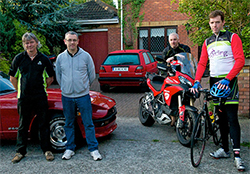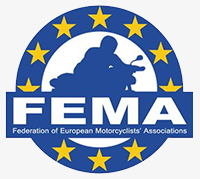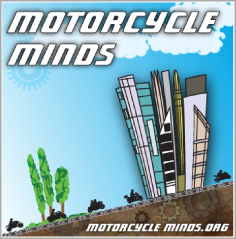 Europe – The Federation of European Motorcyclists Associations FEMA reports that during the summer they carried out mobility tests in various European cities using a combination of different modes of transport.
Europe – The Federation of European Motorcyclists Associations FEMA reports that during the summer they carried out mobility tests in various European cities using a combination of different modes of transport.
FEMA’s conclusion is that if you want to save time and money – use a bike!
However London as a major European city is not included in this mobility test which is surprising considering its size.
Right To Ride would have welcomed the opportunity to get Belfast as a capital city involved with all modes of transport – motorcycle, moped, car, public transport and bicycle.
This in consideration of riders access to bus-lanes, the Network of cycle lanes, car sharing parking and the public transport network that is being stimulated and promoted and the potential of future dedicated free parking spaces for riders in Belfast city centre – and we love a challege!
Save time and money: use a bike!
Powered Two Wheelers – scooters, mopeds and motorcycles – can make a huge difference to improve mobility in Europe.
 This summer, the Federation of European Motorcyclists Associations FEMA, made tests in European cities with different modes of transport.
This summer, the Federation of European Motorcyclists Associations FEMA, made tests in European cities with different modes of transport.
The results from 14 European cities are crystal clear- if you want to save time and money, use a PTW!
A switch from cars to PTWs would also reduce congestions and give financial benefits to the cities.
Work is a huge part of our lives and commuting to work takes more and more time due to congestions. More than 60 % of the population in the European Union lives in urban areas.
The European cities are expected to grow with an increased demand for personal transport for commuting. Many urban areas of Europe are chronically congested, which means an annual cost of € 100 billion per year!
To FEMA, the PTWs are an obvious choice of transport in cities, but not to other stakeholders. In order to investigate the difference in transports, FEMA asked member organizations in Europe to take part in a mobility test. 15 cities in eight countries participated in the first pan European mobility test ever.
The rules were easy: use different modes of transport – motorcycle, moped, car, public transport and bicycle if possible. Start at the same time from a set place in a suburb and head for a goal inside a European city. Find a time keeper to collect the results. Take photos from the test. Send the results to FEMA.
The result is crystal clear all over Europe. The motorcycles and mopeds made the journeys faster in every city.
The average speed for motorcycles and mopeds compared to cars is higher in almost every city. Bicycles took part in the tests in Basel, Lausanne, Dublin, Marseilles, Antwerp and Brussels. The bicycle who took part in Antwerp only spent nine minutes more than the car to travel 22 kilometers! The bicyclist in the city of Marseilles was actually faster than all other modes of transport, due to a bicycle lanes and experience.
The biggest differences between the motorcycle and the car was 38 minutes to travel 29 kilometers in Oslo, (27/ 65 minutes) and 48 minutes to travel 19 kilometers in Dublin (27/75). If you choose to ride a motorcycle instead of drive a car in Oslo, you would save more than one hour every day!
The fact that all motorcyclists have access to bus lanes in Oslo, also gave the rider a safe and pleasant journey. The rider in Dublin saves more than 1,5 hour per day compared to the motorist.
The cost for the journeys, parking and tolls was also compared. Motorcycles and mopeds used less petrol compared to cars. There were no costs for parking motorcycles and mopeds in most cities compared to cars which had to pay up to €25 to park one working day. Cars must also pay toll/congestion tax in Stockholm and Oslo where motorcycles and mopeds are excluded from the city toll.
The PTW-riders spend less money commuting compared to motorists.
The mobility test proves that powered two-wheelers can contribute to improve mobility and reduce congestions all over Europe. Individuals would spend less time and money commuting to work if they use a PTW. A switch to PTW is also profitable for society as a whole, which has been stated in several studies.
It would be easy for the European cities to promote PTWs and improve safety to a low cost, for example by allowing filtering, give access to bus and taxi lanes, open dedicated parking space for PTWs and exempt PTWs from congestion charge.
Original Source – Federation of European Motorcyclists Associations (FEMA) – Click Here
Links & Information
Visit the FEMA website for all the tests reults – Cities overview – Video from the mobility test in France/Island of Réunion – Video from the mobility test in Italy/Rome – Video from the mobility test in Norway/Oslo – A report on the mobility test in Ireland – A report on the mobilitytest in Oslo.
Video from the mobility test in Norway/Oslo – NMCU


Mobility test 15 cities 8 countries in Europe 2014
Italy, Rome
25th June the test was made in Rome with a moped 50 cc, a motorcycle, a car and public transport (bus, metro and tram). All drivers respected speed limits and the rules of traffic. The participants started 08.30 and went 17,5 km on urban roads to the FMI office. The moped was the fastest mode of transport, two minutes faster than the motorcycle. A commuter with car would save 56 minutes and €5 in parking fees per day by choosing a PTW instead in Rome.
Belgium, Antwerp
The test was made in the middle of July, starting in Sint-Katelinje-Waver to Het Steen, Antwerp. There were six different means of transport : motorcycle, car, moped, bicycles, bus/tram and bus/train/tram. The distance was 21 km for moped and bicycles and 26 km for car and motorcycle. The motorcycle did the journey fastest, in 29 minutes. The bicycles made the journey in 60 minutes, only nine minutes slower than the car driver. A commuter would save 44 minutes and € 15 in parking fees per day by choosing to ride a motorcycle instead of a car in Antwerp.
Belgium, Brussels
The ride in Brussels took place at the beginning of September, starting in Leuwen to the FEMA office in Etterbeek. The distance was 29-30 km. There were five different modes of transport ; motorcycle, bicycle, electric bicycle, car and bus/train. The motorcycle did the journey fastest, 35 minutes. The bicycle only used 16 minutes more than the car. A commuter would save 56 minutes every day and €30 in parking fees by choosing a motorcycle instead of a car in Brussels.
Germany, Stuttgart
The test was made 31st July, starting in Ludwigsburg and going to Industriegebiet Feuerbach, Stuttgart. The distance is 10 km. There were three different means of transport ; motorcycle, car and moped 50 cc. The motorcycle did the journey fastest, in 15 minutes, the moped came second with 20 minutes and the car took 22 minutes. A commuter would save 14 minutes per day by choosing a motorcycle instead of a car in Stuttgart.
Germany, Hamburg
The test in Hamburg started in Hüttkahlen and went to Marco-Polo-Terassen in Hamburg, 33,3 km. The traffic was less than normal, due to holidays. Four different means of transport were compared ; motorcycle, car, electric bicycle and public transport. The motorcycle did the journey fastest, 55 minutes 12 seconds, but only 3 minutes 16 seconds faster than the car. Both car and motorcycle had to pay parking fees. Hamburg is the European town in the test with the smallest difference between car and PTW.
Switzerland, Basel
The test was made on August 15th and went from Himmelried to Claraplatz, Basel. The distance is 21,5 km. There were four means of transport tested ; motorcycle, car, public transport and bicycle. The motorcycle did the journey fastest, in 26 minutes. A commuter would save 15 minutes and save €1 per day by using a motorcycle in Basel.
Switzerland, Lausanne
The test was made 28th August and went from Morges to Place Pépinet, Lausanne. The distance is 14 km. Four means of transport took part ; motorcycle, car, bicycle and public transport. The motorcycle did the journey fastest, 18 minutes which is less than half the time of the car. A commuter would save 38 minutes per day by using a motorcycle instead of car in Lausanne.
Sweden, Stockholm
The test took place on August 9th and went from Täby to Kungsgatan, Stockholm. The distance was 18-22 km, with a longer distance for mopeds. There were five means of transport ; motorcycle, moped 45 km, moped 25 km, car and public transport. The motorcycle did the journey fastest, 39 minutes. A commuter would save 23 minutes and €30 for parking/congestion tax per day by choosing a motorcycle instead of a car.
Norway, Oslo
The test took place 2nd September and went from Ski to the Helsfyr metro station in Oslo, 28,7 km. The travel modes were : car, motorcycle, light motorcycle, moped 45 km and train/metro. The two motorcycles did the fastest journeys, in 27 minutes. The car did the same distance in 65 minutes. The moped was 10 minutes faster than the car. A commuter would save one hour and 16 minutes and about €30 for toll and parking every day by using a motorcycle instead of a car in Oslo.
Ireland, Dublin
The test took place 10th September and went from Lexlip to Merrion Square in Dublin, 19 kilometers. There were four means of transport ; motorcycle, bicycle, car and bus. The motorcycle did the journey fastest, 27 minutes. The bicycle was also 35 minutes quicker than the car ! A commuter would save almost two hours every day by using a motorcycle instead of a car in Dublin.
France, Strasbourg
The test took place 15th September and went from Hüttenheim to Conseil Général, Strasbourg, 31 kilometers. Three different modes of transport were compared ; motorcycle, car and train/bicycle. The motorcycle did the journey fastest, in 25 minutes. The car was 13 minutes slower. A commuter would save 26 minutes every day by choosing motorcycle instead of a car in Strasbourg.
France, Caen
The test in Caen was the shortest one, from Bijude to Préfecture in Caen, 6,9 km. Three different modes of transport were compared ; car, motorcycle and public transport. The motorcycle did the journey fastest, in 12 minutes. A commuter would save 14 minutes per day by choosing a motorcycle instead of a car in Caen.
France, Marseilles
There were two tests made in Marseilles in the middle of September. The first was from the center of the suburb Aubagne to Bd Sakakini in Marseilles, 17 kilometers. It was optimal for public transport where the person could go from one railway station to another with only five minutes walk. A commuter would save 1,5 hour every day by choosing a motorcycle instead of a car.
The second test was made in the city of Marseilles and the distance was 7,4 kilometers for car, motorcycle and moped and 6,6 kilometers for bicycle. The cyclist was actually fastest, since he is an experienced cyclist and could cut through the Parc Borély with plenty of bicycle lanes. A commuter would save 15 -20 minutes per day by using vehicle with two wheels in Marseilles.